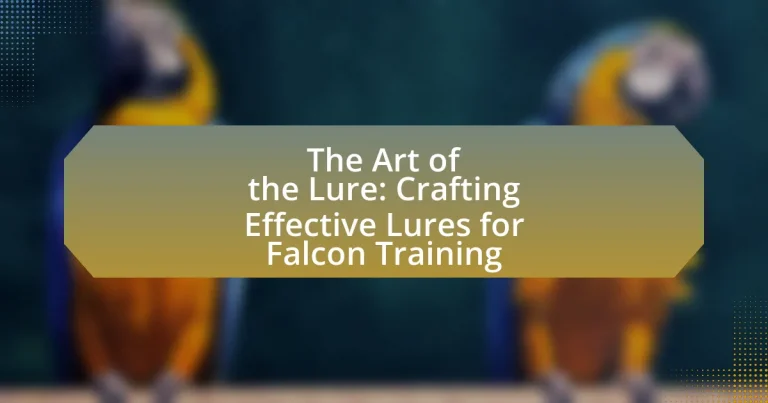The main entity of the article is the technique of using lures in falcon training, known as “The Art of the Lure.” This article provides a comprehensive overview of the significance of lure training in falconry, detailing how lures function to enhance a falcon’s hunting skills and strengthen the bond between the bird and its trainer. It discusses the materials and designs used to create effective lures, the impact of lure characteristics on falcon responses, and the essential skills developed through lure training. Additionally, the article covers best practices for crafting and utilizing lures, troubleshooting tips for improving training outcomes, and the importance of tailoring lures to individual falcon preferences.
What is the Art of the Lure in Falcon Training?

The Art of the Lure in Falcon Training refers to the technique of using a lure, typically a small object or prey replica, to attract and train falcons. This method is essential for developing a falcon’s hunting skills and reinforcing the bond between the bird and the trainer. The lure is often designed to mimic the movement and appearance of live prey, which encourages the falcon to engage in natural hunting behaviors. Effective use of the lure can significantly enhance a falcon’s responsiveness and performance during training sessions, making it a fundamental aspect of falconry.
How does the lure function in the context of falcon training?
The lure functions as a critical training tool in falconry by simulating prey to encourage the bird’s natural hunting instincts. It is typically a weighted object, often resembling a small animal, that is used to attract and reward the falcon during training sessions. By using the lure, trainers can reinforce desired behaviors, such as flying to the lure and returning to the handler, which helps establish a strong bond and improves the bird’s responsiveness. The effectiveness of the lure is supported by its ability to mimic the movement and appearance of live prey, making it an essential component in developing a falcon’s hunting skills and ensuring successful training outcomes.
What materials are commonly used to create effective lures?
Common materials used to create effective lures include feathers, fur, plastic, and metal. Feathers and fur provide realistic movement and mimic the appearance of prey, making them attractive to falcons. Plastic is often used for its versatility and durability, allowing for various shapes and colors that can entice birds. Metal components, such as hooks or weights, add functionality and stability to the lure. These materials are selected based on their ability to simulate natural prey and withstand the rigors of training environments.
How does the design of a lure impact a falcon’s response?
The design of a lure significantly impacts a falcon’s response by influencing its visual and tactile engagement during training. A well-designed lure mimics the movement and appearance of prey, which triggers the falcon’s instinctual hunting behaviors. For instance, lures that incorporate realistic colors, textures, and movements can enhance a falcon’s excitement and motivation to pursue, leading to more effective training sessions. Research indicates that falcons are more likely to respond positively to lures that closely resemble their natural prey in both form and function, thereby improving their performance and training outcomes.
Why is lure training essential for falconry?
Lure training is essential for falconry because it establishes a reliable method for recalling birds of prey, ensuring their safety and enhancing their hunting skills. This training technique utilizes a lure, often resembling prey, to attract the falcon, reinforcing the bond between the falconer and the bird. Studies have shown that consistent lure training improves a falcon’s response time and accuracy during hunts, which is crucial for successful falconry practices. Additionally, lure training helps in managing the bird’s behavior, reducing the likelihood of it flying away or becoming distracted during hunting sessions.
What skills does lure training develop in falcons?
Lure training develops essential skills in falcons, including improved focus, enhanced hunting instincts, and increased responsiveness to commands. This training method encourages falcons to associate the lure with a reward, thereby sharpening their ability to track and pursue moving objects. Studies have shown that consistent lure training can significantly enhance a falcon’s agility and precision during flight, as it mimics natural hunting scenarios. Additionally, the process fosters a stronger bond between the falcon and the trainer, facilitating better communication and trust.
How does lure training enhance the bond between falcon and trainer?
Lure training enhances the bond between a falcon and its trainer by establishing a system of trust and reward. Through consistent use of a lure, the falcon learns to associate the trainer with positive experiences, such as food and successful hunts. This method encourages the falcon to return to the trainer, reinforcing their relationship. Studies in animal behavior indicate that positive reinforcement, like lure training, significantly improves the bond between animals and their handlers by fostering reliance and cooperation.
What are the different types of lures used in falcon training?

The different types of lures used in falcon training include feathered lures, fur lures, and mechanical lures. Feathered lures are designed to mimic the movement of birds, often featuring real feathers to attract the falcon’s attention. Fur lures simulate small mammals, appealing to the falcon’s hunting instincts. Mechanical lures, which may include remote-controlled devices, provide dynamic movement to engage the falcon further. These lures are essential tools in training, as they help develop the falcon’s hunting skills and improve recall.
How do various lure designs cater to different training needs?
Various lure designs cater to different training needs by addressing specific aspects of falcon behavior and training objectives. For instance, lures designed with realistic prey shapes and colors enhance a falcon’s hunting instincts, promoting effective chase and capture behaviors. Additionally, lures that incorporate sound or movement can stimulate a falcon’s interest and engagement during training sessions, making them more effective for teaching recall and response commands. Research indicates that the use of varied lure designs can significantly improve training outcomes by aligning with the natural predatory instincts of the falcon, thereby facilitating a more efficient learning process.
What are the characteristics of a traditional lure?
Traditional lures are characterized by their use of natural materials, vibrant colors, and specific shapes designed to mimic prey. These lures often incorporate feathers, fur, or other organic elements to create a realistic appearance that attracts falcons. The design typically includes a weighted body for stability during flight and a tail that moves to simulate the action of live prey. Historical practices in falconry emphasize the effectiveness of these lures, as they have been used for centuries to train birds of prey by engaging their hunting instincts.
How do modern lures differ from traditional ones?
Modern lures differ from traditional ones primarily in their materials and design features, which enhance their effectiveness in falcon training. Traditional lures often utilized natural materials like feathers and fur, while modern lures incorporate synthetic materials that provide durability and a more realistic appearance. Additionally, modern lures may include features such as weighted bodies for better aerodynamics and bright colors or patterns that attract the attention of falcons more effectively. These advancements are supported by studies indicating that the use of synthetic materials can improve visibility and mimic prey movement, leading to more successful training outcomes.
What factors should be considered when selecting a lure?
When selecting a lure for falcon training, key factors include the lure’s weight, material, color, and movement. The weight of the lure affects how the falcon interacts with it; a properly weighted lure ensures that the falcon can easily carry and manipulate it during training sessions. The material should be durable yet lightweight, allowing for repeated use without significant wear. Color plays a crucial role in visibility; bright or contrasting colors can attract the falcon’s attention more effectively. Lastly, the movement of the lure, whether it mimics prey or creates an enticing flutter, is essential for engaging the falcon’s hunting instincts. These considerations are supported by practical training experiences that demonstrate the importance of each factor in enhancing the effectiveness of the lure during falconry.
How does the size of the lure affect training outcomes?
The size of the lure significantly impacts training outcomes in falconry by influencing the bird’s motivation and engagement during training sessions. Larger lures tend to attract more attention and stimulate a stronger predatory response, which can enhance the bird’s focus and willingness to participate in training activities. Research indicates that the size of the lure can affect the success rate of training exercises, as birds are more likely to respond positively to lures that mimic the size of their natural prey, thereby improving their learning and retention of skills.
What role does the weight of the lure play in falcon training?
The weight of the lure is crucial in falcon training as it directly affects the bird’s ability to catch and retrieve it. A properly weighted lure ensures that the falcon can effectively engage in the training exercise without excessive strain or difficulty. For instance, if the lure is too heavy, it may discourage the falcon from pursuing it, while a lure that is too light may not provide enough resistance to simulate real hunting conditions. This balance is essential for developing the falcon’s strength, agility, and hunting instincts, ultimately enhancing its performance during training sessions.
How can trainers effectively craft their own lures?

Trainers can effectively craft their own lures by selecting materials that mimic the appearance and movement of natural prey. This involves using feathers, fur, or synthetic materials that closely resemble the target species, ensuring that the lure is visually appealing and enticing to the falcon. Additionally, incorporating elements that create sound or movement, such as bells or weighted components, can enhance the lure’s effectiveness by simulating the behavior of live prey. Research indicates that lures designed with realistic features significantly improve a falcon’s hunting response, as they trigger instinctual behaviors associated with prey capture.
What steps are involved in creating a custom lure?
Creating a custom lure involves several key steps: selecting materials, designing the lure shape, adding color and finish, incorporating movement features, and testing the lure’s effectiveness. First, choose materials such as wood, plastic, or metal that suit the desired durability and buoyancy. Next, design the shape of the lure to mimic the prey species targeted in falcon training. After that, apply colors and finishes that enhance visibility and appeal to the falcon. Then, integrate movement features like rattles or spinning components to attract attention. Finally, test the lure in various conditions to ensure it performs effectively in attracting falcons.
What tools and materials are necessary for crafting lures?
To craft lures for falcon training, essential tools and materials include a lure body, feathers, hooks, and a line. The lure body can be made from materials like foam or wood, which provide buoyancy and durability. Feathers are crucial for mimicking prey and can be sourced from various birds, while hooks ensure the lure can be effectively used in training scenarios. A strong line is necessary for attaching the lure to a rod or for retrieval. These components collectively enhance the effectiveness of the lure in training falcons to hunt.
How can trainers personalize lures to suit their falcon’s preferences?
Trainers can personalize lures to suit their falcon’s preferences by observing the falcon’s hunting behavior and dietary inclinations. By identifying specific prey types that the falcon shows interest in, trainers can create lures that mimic these prey, enhancing the falcon’s engagement during training sessions. For example, if a falcon prefers small mammals over birds, trainers can design lures that resemble the size, shape, and movement of those mammals. This tailored approach increases the effectiveness of training, as studies have shown that animals respond better to stimuli that closely resemble their natural prey.
What common mistakes should be avoided when crafting lures?
Common mistakes to avoid when crafting lures include using inappropriate materials, neglecting the weight balance, and failing to mimic natural prey accurately. Using materials that are too heavy or too light can affect the lure’s performance and its ability to attract falcons. Additionally, improper weight distribution can lead to erratic movement, making the lure less appealing. Lastly, not accurately replicating the size, color, and movement of natural prey can result in a lack of interest from the falcon, as they rely on visual cues to identify potential targets.
How can improper lure design hinder training progress?
Improper lure design can significantly hinder training progress by failing to engage the falcon’s natural instincts and behaviors. When lures do not mimic the appearance, movement, or scent of prey, falcons may lose interest or become confused during training sessions. This lack of engagement can lead to decreased motivation and ineffective learning, ultimately prolonging the training process. Research indicates that effective lure design should incorporate realistic features that stimulate a falcon’s predatory drive, as evidenced by studies showing improved training outcomes when lures closely resemble natural prey.
What are the signs of a poorly made lure?
Signs of a poorly made lure include uneven weight distribution, which can cause erratic movement in water, and substandard materials that may lead to quick wear and tear. Additionally, poorly constructed lures often have weak connections, such as loose hooks or inadequate knots, increasing the risk of losing the lure during use. Inconsistent paint jobs can also indicate poor craftsmanship, as they may affect the lure’s visibility and attractiveness to falcons. Lastly, lures that do not mimic the intended prey effectively, either in shape or color, are likely to be ineffective in training.
What are the best practices for using lures in training sessions?
The best practices for using lures in training sessions involve ensuring the lure is visually appealing and mimics the movement of prey. This approach captures the falcon’s attention and encourages natural hunting behaviors. Additionally, using a consistent reward system reinforces positive behavior, making the training more effective. Research indicates that falcons respond better to lures that closely resemble their natural prey in size and color, enhancing their engagement during training sessions.
How can trainers effectively introduce lures to their falcons?
Trainers can effectively introduce lures to their falcons by gradually associating the lure with positive reinforcement, such as food rewards. This method involves initially presenting the lure in a familiar environment where the falcon feels secure, allowing the bird to explore and investigate the lure without pressure. As the falcon shows interest, trainers should reward any interaction with the lure, reinforcing the connection between the lure and a positive outcome. Research indicates that consistent and gradual exposure to the lure enhances the falcon’s willingness to engage with it, ultimately leading to successful training sessions.
What techniques can enhance the effectiveness of lure training?
To enhance the effectiveness of lure training, utilizing techniques such as consistent timing, varied lure movement, and positive reinforcement is essential. Consistent timing ensures that the lure is presented at the right moment, aligning with the falcon’s natural hunting instincts, which increases engagement. Varied lure movement mimics the unpredictable behavior of prey, capturing the falcon’s attention and encouraging more dynamic responses. Positive reinforcement, such as rewarding the falcon immediately after it successfully interacts with the lure, strengthens the association between the lure and successful hunting, leading to improved training outcomes. These techniques are supported by behavioral training principles that emphasize the importance of timing and reinforcement in animal learning.
What troubleshooting tips can help improve lure training outcomes?
To improve lure training outcomes, ensure consistency in the training environment and the use of the lure. Consistent conditions help the falcon associate the lure with positive experiences, enhancing its responsiveness. Additionally, varying the lure’s movement and incorporating rewards can maintain the falcon’s interest and motivation. Research indicates that falcons trained in stable environments with predictable cues show higher success rates in lure training, as they develop stronger associations with the lure.
How can trainers address a falcon’s disinterest in the lure?
Trainers can address a falcon’s disinterest in the lure by varying the type of lure used and ensuring it mimics the falcon’s natural prey. Using different materials, colors, and scents can stimulate the falcon’s interest. Research indicates that falcons are more likely to engage with lures that closely resemble their hunting targets, such as small birds or rodents. Additionally, incorporating movement or sound into the lure can enhance its appeal, as falcons are attracted to dynamic stimuli.
What adjustments can be made if a falcon is not responding as expected?
If a falcon is not responding as expected, adjustments can include modifying the lure’s design, changing the training environment, or altering the timing of the lure presentation. Modifying the lure’s design may involve using different colors, sizes, or materials to better attract the falcon’s attention. Changing the training environment can help by reducing distractions or introducing new stimuli that may engage the falcon more effectively. Additionally, altering the timing of the lure presentation can optimize the falcon’s response, as timing plays a crucial role in reinforcing desired behaviors during training sessions. These adjustments are supported by the principles of operant conditioning, which emphasize the importance of adapting training methods to the individual bird’s responses.


